Tuol Sleng Genocide Museum, Phnom Penh, Cambodia
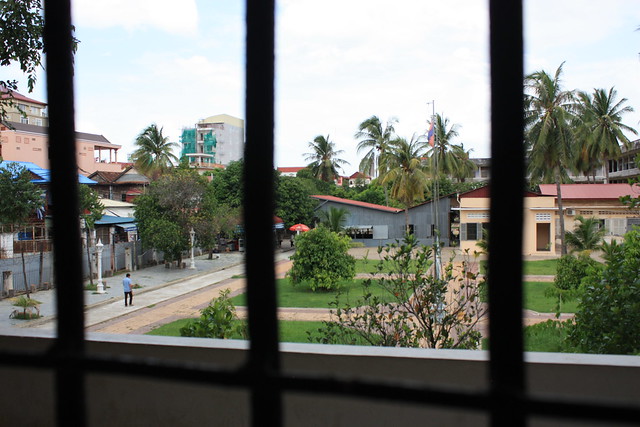
Barred windows at Tuol Sleng.
Note: I know the last few weeks haven’t been fun or light reading. Cambodian history isn’t fun or light. I appreciate you guys sticking with me while I’ve waded through it. This will be my last post focusing on the horrors of the Khmer Rouge. There is more to the country than this dark chapter. I just wanted to make sure I treated the topic with the gravity and attention it deserved. Tomorrow, I swear, I will post something that will make you smile.
After we went to Choeung Ek, we headed back to town, straight to the Tuol Sleng Genocide Museum. We paid $2 for admission, and another $6 for a guide. His name was Samnang, and he was my age – born in 1980, just after the Vietnamese Army arrived and liberated the country from the Khmer Rouge. His parents had survived the KR labor camps.
“I don’t know how,” he said.
When he was a child, he explained that Phnom Penh had been a ghost town. It was only in recent years that people had started returning to the city. The Khmer Rouge had emptied it out within a week of taking power.
Later, some would return to the capital, but not of their own volition. The KR would send people from the labor camps to Tuol Sleng, where they were tortured, interrogated, and ultimately sent to the Killing Fields to be executed. Though it is the most widely known prison from the Khmer Rouge era, it was only one of 150 sites like it throughout the country.
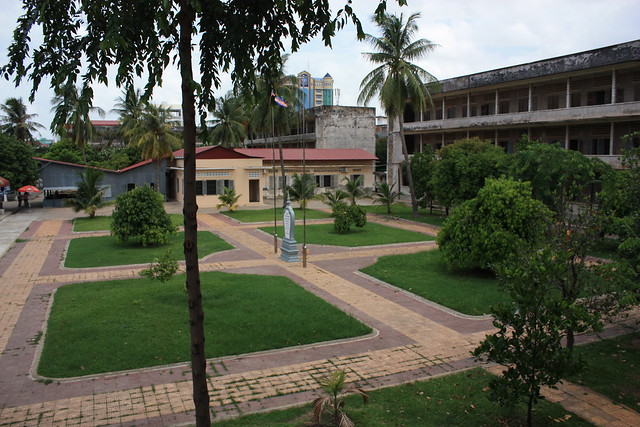
The name of the prison, in Khmer, means “hill of the poisonous trees.” From 1975 to 1979, it was known by the codename Security Prison 21, or S-21. Today, it is a museum, a grave reminder of what took place here.
There was a large sign out front, with the rules that the Khmer Rouge had imposed upon the prisoners here.
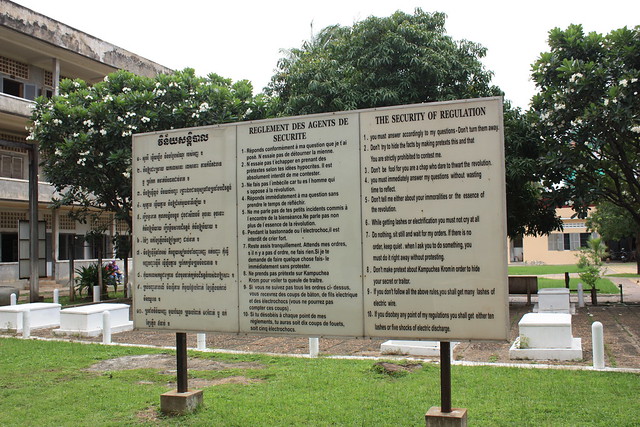
Fuck absolutely all of this.
It reads (verbatim):
The Security of Regulation
- you must answer according to my questions – Don’t turn them away
– - Don’t try to hide the facts by making pretexts this and that
You are strictly prohibited to contest me
– - Don’t be fool for you are a chap who dare to thwart the revolution.
– - you must immediately answer my questions without wasting time to reflect.
– - Don’t tell me either about your immoralities or the essence of the revolution.
– - While getting lashes or electrification you must not cry at all
– - Do nothing, sit still and wait for my orders. If there is no order, keep quiet. when I ask you to do something, you must do it right away without protesting.
– - Don’t make pretext about Kampuchea Krom in order to hide your secret or traitor.
– - If you don’t follow all the above rules, you shall get many lashes of electric wire.
– - If you disobey any point of my regulations you shall get either ten lashes or five shocks of electric discharge.
I was instantly terrified. That was the whole point of this place, I’m sure.
Before the rise of the KR, Tuol Sleng had been a school. But the Khmer Rouge took it over and draped the buildings in iron sheets and barbed wire, which was electrified to prevent escape.
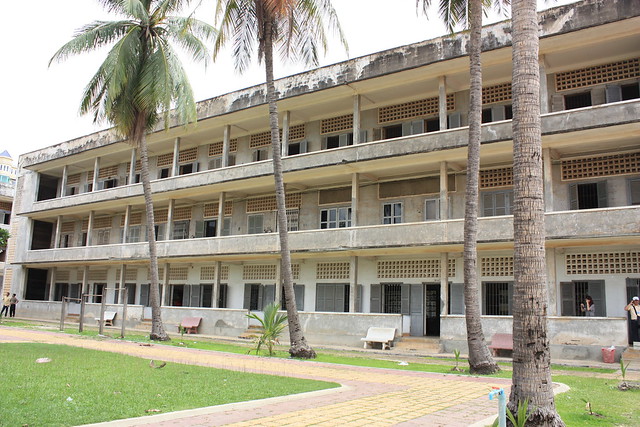
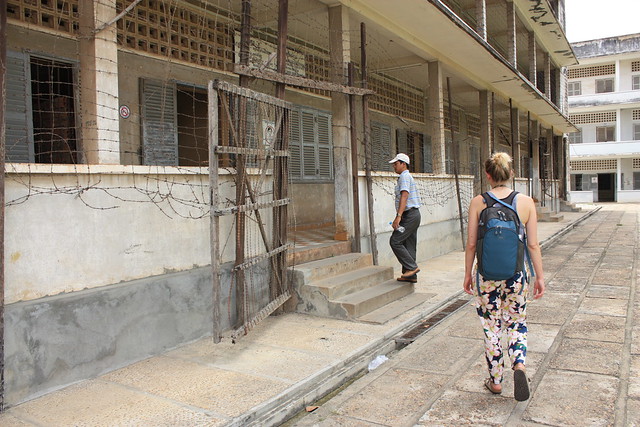
We follow Samnang into one of the buildings.
The barbed wire has since been removed on all but one building. We followed Samnang into it. He explained that the first floor was occupied by interrogation rooms, the second floor was filled with cells, and the top floor was administrative offices (a detail which I find particularly perverse; that people were upstairs doing paperwork while people were dying below).
We walked into an interrogation room first.

Prisoners were shackled directly to the metal bed frame. The metal ammunition box at the end of the bed served as a latrine.
I read that the guards themselves never did interrogations. This was reserved for higher-ranking officials. The guards were instructed not to talk, touch, or interact with the prisoners. Failure to do so could lead to their own imprisonment, torture, and death.
In an adjacent room, there were some of torture devices used by the Khmer Rouge. There are also paintings by Cambodian artist Vann Nath illustrating the kinds of torture that took place at S-21. He had been a prisoner here himself, and was spared by the Comrade Duch so that he could paint portraits of Pol Pot.
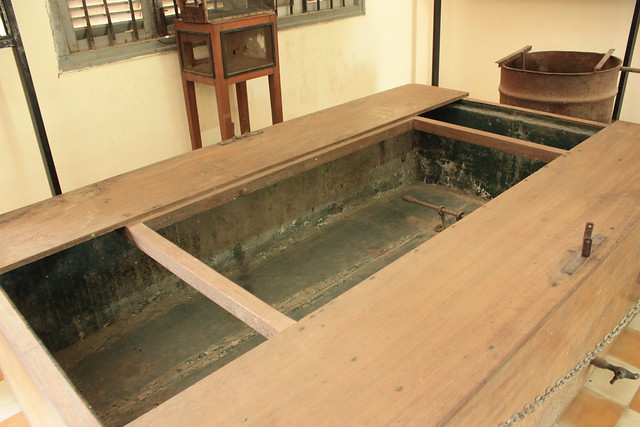
Water torture device.
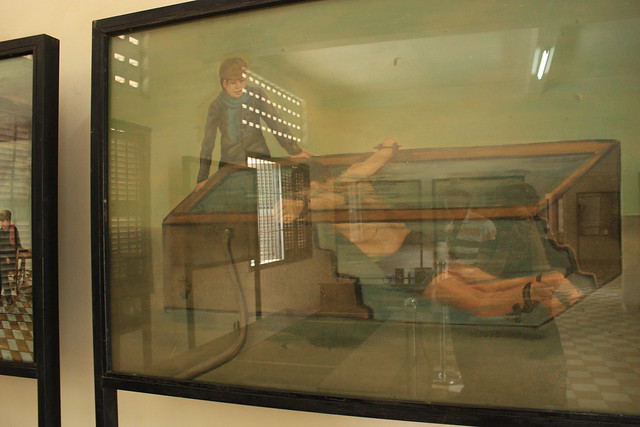
Painting by former S-21 prisoner Vann Nath, illustrating how the water torture box worked. (Apologies for the glare.)
When the Vietnamese army invaded, the KR left here in a rush, leaving corpses still chained to the beds in the interrogation rooms.
Vietnamese photographer Ho Van Tay was the first person to enter S-21 with a camera. Supposedly he and his colleagues followed the stench of death. His photos, of mutilated, rotting bodies are posted throughout Tuol Sleng. (I didn’t take any photos of these. If you want, you can do a search for them. They are hardly recognizable as having once been human beings.)
One the second floor was where prisoners were held when they weren’t being tortured. Brick walls had been erected inside, dissecting the classrooms into small cells, roughly 1m wide by 2m deep. Prisoners were locked in close to one another, but forbidden to speak or interact. They were shackled at all times, forced to sleep on the ground. Their lavatory was a bucket, placed in the corner of their cell. They had to ask permission to use it.
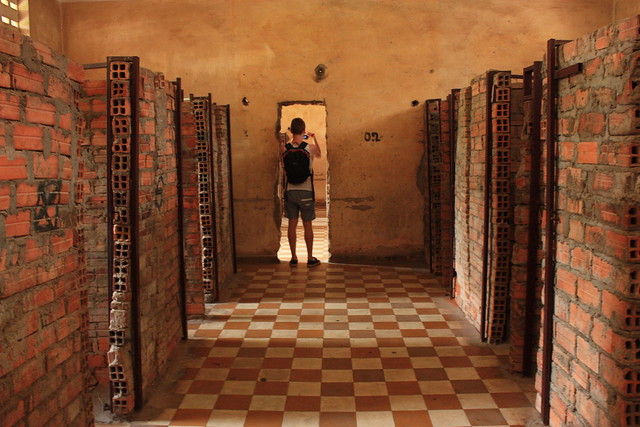
Prisoner cells inside of Tuol Sleng.
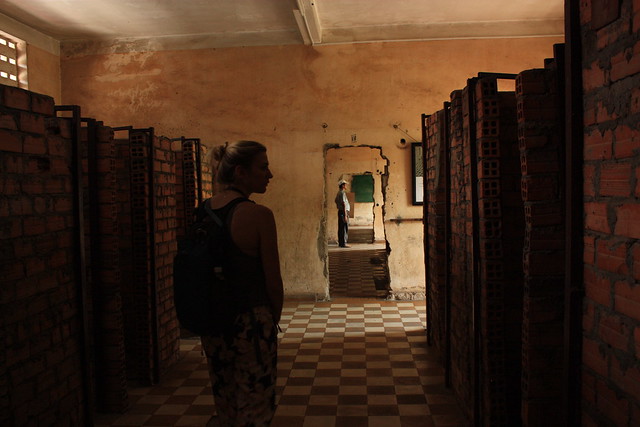
Nicci, walking through.

Interior of a cell.
Incarceration would last anywhere from two to four months. Important political prisoners would last a few months longer. Many died during interrogation and torture. A very small percentage of the prisoners were female; women who did come through Tuol Sleng were frequently raped by their interrogators.
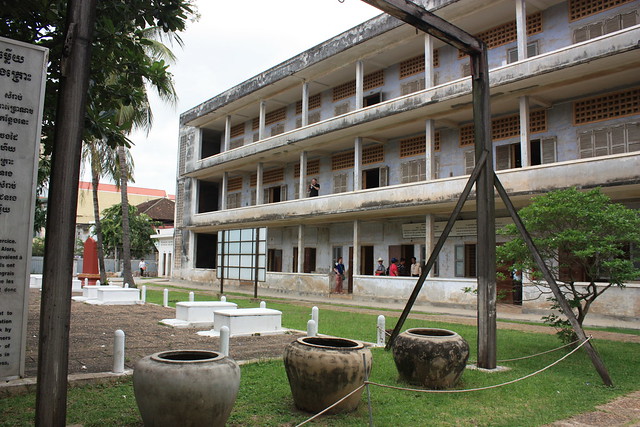
The gallows at Tuol Sleng. Prisoners were hung here by their feet, and repeatedly dropped headfirst into the pots of water below.
Those who managed to survive their incarceration were sent to The Killing Fields.
Estimates of how many people came through the doors of the prison vary. One report put the number at around 11,000, not including roughly 2,000 children who were also executed. Another figure put the number at 30,000. The number we heard around Phnom Penh, and from Samnang, was that about 20,000 people had come through Tuol Sleng during the years that the Khmer Rouge ruled the country (about 100 or so were foreigners. Some were yachtsmen and sailors whose boats were intercepted by the KR. They were all killed).
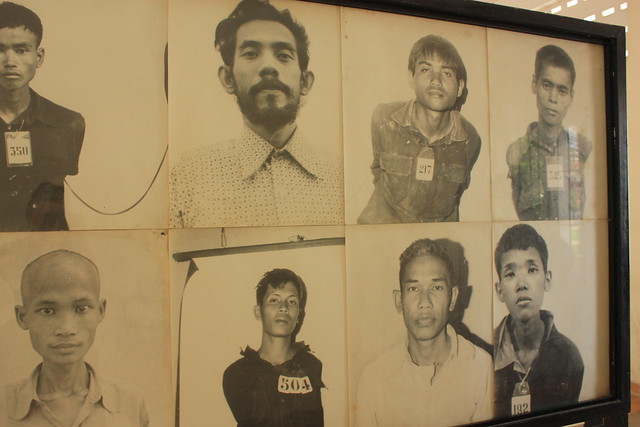

Of those 20,000 people, 11 survived.
That’s it. 11 people. 7 adults, 4 children (it was photographer Ho Van Tay and his crew who found the little ones in a pile of discarded clothing. There were five of them, and they were all literally starving. The youngest did not survive.) Samnang explained that the adults had been found at the Killing Fields, about to be murdered.
Two of those adult survivors, now old men, and one of those children, now grown, are believed to be the only former inmates of Tuol Sleng who are still alive. (Vann Nath, the painter I mentioned earlier, died in 2011.)
The two older gentlemen were there that day – Chum Mey, a mechanic, and Bou Meng, an artist. Both adults at the time of their incarceration, they were each kept alive because of their value to the Khmer Rouge. Chum Mey was able to fix machinery, and Bou Meng, like Van Nath, was forced to paint portraits of KR officials. Both men lost their families to the Khmer Rouge. Chum Mey’s wife and infant son were shot in front of him. Bou Meng’s wife was killed at S-21. He carries a small copy of her prison portrait with him in his wallet. In 2009, he spoke to the The New York Times about it:
“Sometimes when I sit at home I look at the picture and everything seems fresh,” he said. “I think of the suffering she endured, and I wonder how long she stayed alive.”
Mr. Bou Meng has since remarried twice, but he remains shackled to his memories. “I know I should forget her,” he said, “but I can’t.”
Each was there, signing books they’d written, and taking photos with guests. The photo-taking felt a bit strange to Nicci and I – it seemed wrong to reduce these men to a photo-opportunity. They would pose for the cameras, but their eyes never really changed. They remained heavy and profoundly sad.
As we passed, Nicci pressed her palms together and bowed slightly at Bou Meng, the way we’d seen Khmer people do. He returned the gesture.
Later, I would make eye contact with Chum Mey, and bow as Nicci had. He would reply in kind. Nicci and would talk about it later, and realize that we were far more comfortable with those quiet exchanges than we would have been with any photo.
A short while later, we said goodbye to Samnang, and left.
I wish I had more to say about it. Some pithy little comment to tie it all together. But I don’t. Like I said, most of the KR evaded punishment. The head official at Tuol Sleng, Comrade Duch, was finally tried only a few short years ago. He is now serving a life sentence.
The conditions in which he is imprisoned, I’m sure, are far, far nicer than any he submitted others to.









Leave a Comment